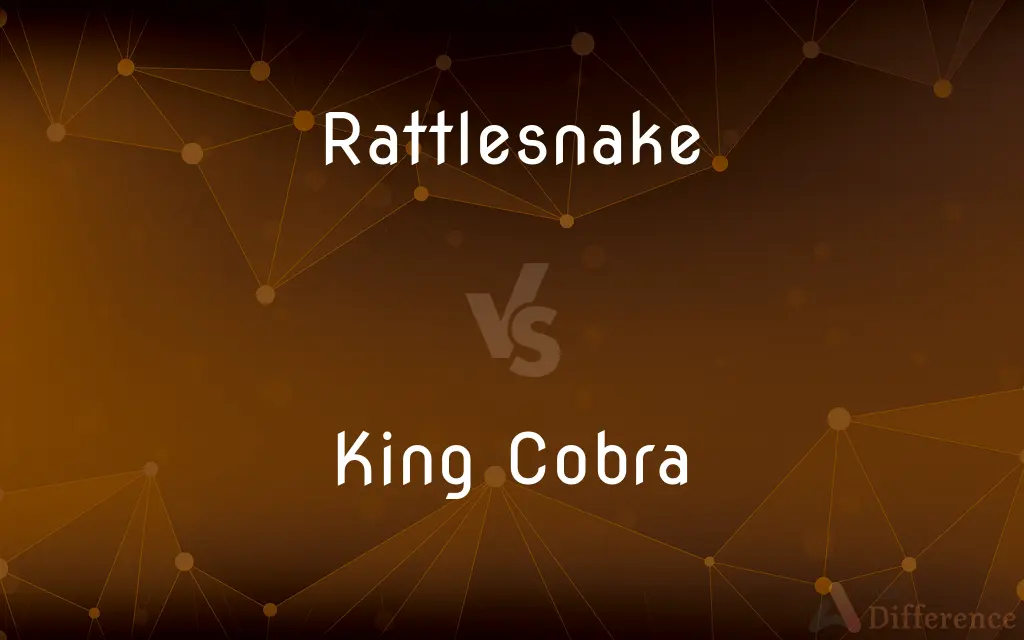Rattlesnake vs. King Cobra — What's the Difference?
By Tayyaba Rehman & Fiza Rafique — Published on March 3, 2024
Rattlesnakes are venomous snakes found primarily in the Americas, known for their distinctive rattle. King cobras, the world's longest venomous snakes, are found in Asia and are revered for their hood and ability to "stand up."

Difference Between Rattlesnake and King Cobra
Table of Contents
ADVERTISEMENT
Key Differences
Rattlesnakes, belonging to the genus Crotalus, are native to the Americas and easily identified by their unique rattle at the end of their tail, used as a warning signal to predators and humans. King cobras (Ophiophagus hannah), on the other hand, are native to South and Southeast Asia and are not only the world’s longest venomous snakes but also distinguished by their hood, which they expand when threatened, and their ability to raise a significant portion of their body off the ground.
The venom of a rattlesnake is hemotoxic, leading to tissue damage, disruption of blood clotting, and organ failure. In contrast, the king cobra's venom is primarily neurotoxic, affecting the nervous system, leading to paralysis, and potentially death due to respiratory failure if antivenom is not administered promptly.
Rattlesnakes are known for their preference for arid environments, though they can be found in a wide range of habitats, from deserts to forests. King cobras prefer dense highlands, forests, and swamps. They are also notable for their intelligence, including the ability to recognize their handlers.
The diet of rattlesnakes mainly consists of small mammals, birds, and occasionally other reptiles. King cobras have a more specialized diet, primarily feeding on other snakes, including venomous species, earning them the "king" in their name for their dominance in the reptile food chain.
In terms of reproduction, rattlesnakes give birth to live young, a trait known as ovoviviparity. King cobras are unique among venomous snakes for their nesting behavior; the female builds a nest for her eggs and guards them until they hatch, demonstrating a rare level of parental care in snakes.
ADVERTISEMENT
Comparison Chart
Habitat
Americas
South and Southeast Asia
Venom Type
Hemotoxic
Neurotoxic
Distinguishing Feature
Rattle on tail
Hood and ability to "stand up"
Diet
Small mammals, birds
Primarily other snakes
Reproduction
Ovoviviparous (live birth)
Oviparous (lays eggs) with nesting behavior
Length
Up to 8 feet (varies by species)
Up to 18 feet
Behavior
Defensive, uses rattle as warning
Aggressive when threatened, can display intelligence
Conservation Status
Varies by species
Vulnerable
Compare with Definitions
Rattlesnake
A venomous snake known for its distinctive tail rattle.
The hiker heard the rattlesnake's warning rattle before seeing it on the trail.
King Cobra
The world's longest venomous snake, known for its hood.
The king cobra raised its hood as a warning to the intruder.
Rattlesnake
Gives birth to live young.
She observed a rattlesnake giving birth to a dozen live babies.
King Cobra
Exhibits unique nesting behavior.
The female king cobra meticulously built a nest for her eggs.
Rattlesnake
Prefers arid environments but adaptable to various habitats.
Rattlesnakes are often found in desert regions but can live in forests and swamps.
King Cobra
Specializes in eating other snakes.
The king cobra's diet mainly consists of other venomous and non-venomous snakes.
Rattlesnake
Hemotoxic venom causes tissue damage and organ failure.
The rattlesnake bite led to severe tissue damage requiring medical attention.
King Cobra
Native to South and Southeast Asia, prefers forests.
King cobras are often found in the dense forests of India.
Rattlesnake
Diet includes small mammals and birds.
Rattlesnakes primarily feed on rodents and small birds.
King Cobra
Neurotoxic venom can be fatal without treatment.
The king cobra's bite can cause paralysis and respiratory failure.
Rattlesnake
Any of various venomous pit vipers of the genera Crotalus and Sistrurus of the Americas, having at the end of the tail a series of loosely attached, horny segments that can be vibrated to produce a rattling or buzzing sound.
Rattlesnake
Any of various venomous American snakes, of genera Crotalus and Sistrurus, having a rattle at the end of its tail.
Rattlesnake
Pit viper with horny segments at the end of the tail that rattle when shaken
Common Curiosities
Which is more dangerous, a rattlesnake or a king cobra?
Danger can depend on the situation and location. King cobras have more potent neurotoxic venom and can deliver larger quantities, but rattlesnakes' hemotoxic venom is also highly dangerous. The accessibility of medical treatment plays a crucial role in outcomes.
How does a king cobra's diet affect its behavior?
King cobras' specialized diet of other snakes, including venomous species, demonstrates their dominance in their ecosystem and may contribute to their aggressive defense mechanisms when threatened.
Can a rattlesnake's venom kill a human?
Yes, without prompt medical treatment, a rattlesnake's venom can be fatal to humans due to its hemotoxic properties.
What should you do if bitten by a rattlesnake or king cobra?
Seek immediate medical attention, keep calm and immobile to slow the spread of venom, and do not attempt traditional first aid methods like sucking out the venom.
How are these snakes important to their ecosystems?
Both play crucial roles as predators, controlling populations of their prey and thus maintaining the balance within their ecosystems.
Are rattlesnakes protected in any regions?
Yes, some species of rattlesnakes are protected under conservation laws in various regions due to habitat loss and declining populations.
What makes king cobras unique among venomous snakes?
Their length, intelligence, specialized diet, neurotoxic venom, and the female's nesting behavior make them unique among venomous snakes.
Can king cobras and rattlesnakes be kept as pets?
While it is legal in some places with proper permits, keeping these venomous snakes as pets is highly discouraged due to their dangerous venom and specific care needs.
How can you safely observe these snakes in the wild?
Maintain a safe distance, do not provoke or attempt to handle them, and always be aware of your surroundings in areas where they are known to live.
How do conservation efforts for these snakes differ?
Conservation efforts vary based on habitat, threats, and species status. King cobras are often part of broader conservation programs due to their habitat needs, while rattlesnake conservation can involve specific protections and habitat restoration.
Share Your Discovery

Previous Comparison
iMacros vs. Greasemonkey
Next Comparison
Plus Twos vs. Plus FoursAuthor Spotlight
Written by
Tayyaba RehmanTayyaba Rehman is a distinguished writer, currently serving as a primary contributor to askdifference.com. As a researcher in semantics and etymology, Tayyaba's passion for the complexity of languages and their distinctions has found a perfect home on the platform. Tayyaba delves into the intricacies of language, distinguishing between commonly confused words and phrases, thereby providing clarity for readers worldwide.
Co-written by
Fiza RafiqueFiza Rafique is a skilled content writer at AskDifference.com, where she meticulously refines and enhances written pieces. Drawing from her vast editorial expertise, Fiza ensures clarity, accuracy, and precision in every article. Passionate about language, she continually seeks to elevate the quality of content for readers worldwide.
















































